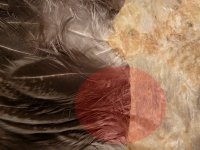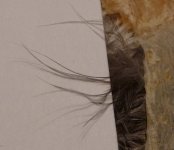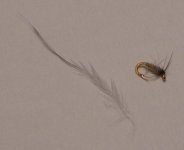Bloods are new, growing feathers, that haven't fully developed.
They are common on young pheasants and ducks and on fowl that are coming through molt.
On the living birds, the feather stems are thick and soft and still have blood flowing into the feather through the stem to provide nutrients to grow the feathers. It's similar to antler growth (growing antlers are full of blood providing nutrients.)
As the feather matures past blood stage, part of the cuticle (or whatever the proper name is) sheds. You can sometimes find these as short stem tubes on the shaft of the immature feather.
The difference between a blood and a fully mature feather is similar to the difference between a plant terminal bud and the teminal end after the bud shoots.
In the immature stage both the bud and the blood are compact and dense (and for feathers the tips of barbels are all about the same length). When it matures the barbels are stretched out along the length of the bolted feather stem.
Another name for bloods is "pin feathers". They are the most difficult to pluck without tearing skin.
If you ever get the chance to pluck a duck or chicken you'll quickly learn.
If you hunt stocked pheasants, you'll find plenty of bloods on the skin, especially tails and wings.
In fact, most birds plumage matures just prior to mating (spring), when the attractiveness of plumage is key. For ducks, molt ususally happens in summer and continues into the fall.
Most of the ducks and other game birds killed during the fall (especially the majority killed - birds of the year) are not in prime plumage, but body fat and muscle (meat) condition is prime.
An immature fowl neck or rump patch intended for fly tying will have a number of young feathers and not be suited for dry flys, because the stem is not fully developed and the barbels are not at their peak for stiffness and orientation to the shaft.
Too old (in terms of stage of feather cycle) and the feather becomes brittle and difficult to use well. (Improper treatment, including some forms of dying can cause brittleness or deformation of the feather as well.)
A number of fowl, such as grouse and pheasant, have secondary feathers (called "down" on ducks). These feathers are fluffy and insulative.
Pheasant secondary feathers (a natural grey) when dyed olive make great legs for cress bugs and sow bugs, but the stems are rather weak. However, they can be protected to improve fly durability by wrapping them in the groves between dubbed body wraps. On pheasants, these feathers are off-shoots from the base of primary body feathers. On ducks, the down remains when the primary body feathers are removed.






